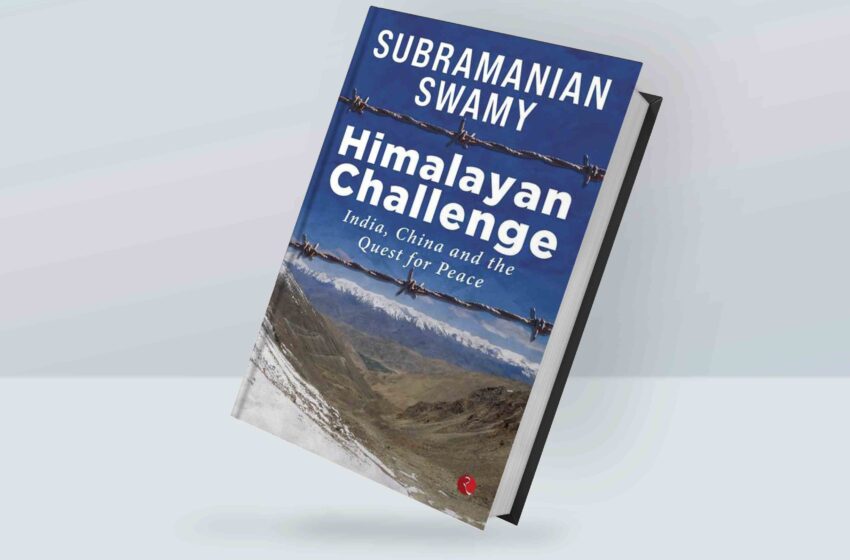‘Himalayan Challenge: India, China and the Quest for Peace’ review: The search for a new modus vivendi with China

The past 12 months have upended many of the basic assumptions about the India-China relationship, with the unprecedented crisis along the Line of Actual Control (LAC) and the biggest loss of life of Indian soldiers on the China border since 1967, putting a large question mark on the model of engagement since Rajiv Gandhi’s pathbreaking 1988 visit.
That the model, predicated on shelving differences, maintaining peace on the border, and finding other areas of cooperation while managing competition, needs revisiting seems to be the growing consensus among most former senior Indian officials who have dealt with China.
An intervention
In his new book, Himalayan Challenge, Subramanian Swamy offers an intervention in this on-going debate and suggests a new way of engaging China — one that will involve, in his view, reassessing many of India’s fundamental positions on issues such as Tibet and the boundary.
Few Indians have engaged with China for as long as Swamy has, going back to his time at Harvard University in the 1960s. An association that began with his interest in China’s economy evolved into a political association in the late 1970s and early 1980s, when he was among few Indians to travel to China and meet with the leadership. In the book, Swamy recounts his meetings with then leader Deng Xiaoping and provides a first-hand account of how Deng made the case for restoring the relationship after the post-war freeze.
Swamy occupies a unique position when it comes to China that escapes easy labelling. He has been comfortable to take positions at variance with many of those in the Bharatiya Janata Party, which he represents as a Member of Parliament. He is also a member of the party’s national executive. He is among few Indian political figures who has, over decades and regardless of the ups-and-downs in relations, maintained regular contacts in China and travels there frequently.
In his writings, and in this book, he has refrained from equating relations with China and those with Pakistan. While he can broadly be said to advocate a hard line in dealing with Pakistan, he argues India has to find a way to engage and live with China, and he is under no illusions about the power deferential that India will have to contend with.
Among the most interesting chapters of this book is Swamy’s delving into the long history of contact between India and China going back to the early Buddhist interactions. He provides a colourful re-telling of the early travels of Indians to China and the importance with which they were received, and asks why those stories remain far less well-known than those of Chinese traveller-monks who came to India.
His chapter on Tibet will certainly generate some debate, as he takes a hard look at the inconsistencies of how India has dealt with Tibet, going back to Nehru and more recently Vajpayee’s 2003 visit, when India affirmed its official position that Tibet is a part of China. He argues Tibet still remains a core issue at the heart of India-China problems, and this is a debate that needs to be resolved, as Indian policy, in his view, vacillates in between officially recognising Tibet’s status as a part of China while also continuously exploring how the “Tibet card” can be used effectively. “If our intentions are consistent,” he says, “then it is necessary” that those “are understood as such by China…. Alternatively, if we believe Tibet to be an independent country… then an entirely different course in our diplomacy and military strategy is called for.”
The boundary issue
Swamy pulls no punches in assessing the current stand-off with China along the LAC and the crisis of 2020. He is critical of how the government has handled relations with China, and notes that he had, in 2016, warned then BJP President and now Home Minister Amit Shah, based on what he had heard from Beijing, that relations “were deteriorating” and “may end up in a major conflict in three to four years.” Shah was “dismissive” of this, he writes, and “sang the usual tune of Modi being highly popular everywhere”.
He writes that the government has taken “soft measures in sticking together a response” to the current crisis and criticises the lack of transparency. He says there has been “an inability to take a unanimous position” which is “disturbing and fraught with national security consequences.” The matter of “acknowledging Chinese possession of Indian territory”, he writes, “cannot be treated as bad optics”.
Swamy argues that “pragmatism” should dictate how India approaches a boundary settlement, and he makes a case for why pursuing a settlement that sees both sides find a “mutually convenient and maintainable border” is in India’s long-term interests. Only a settled border, he says, will enable India to pursue its more important long-term goal which, in his view, is “globally being a part of the triumvirate” with the U.S. and China.
Himalayan Challenge: India, China and the Quest for Peace; Subramanian Swamy, Rupa, ?595
source: The Hindu